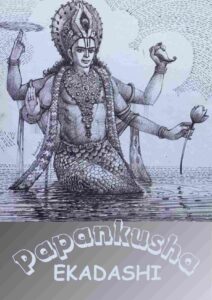
Ekadashi Tithi Begins: at 09:08 AM on Oct 13, 2024
Ekadashi Tithi Ends: at 06:41 AM on Oct 14, 2024
Parana Time –On 14th Oct, 01:20 PM to 03:43 PM
Note: “Parana” is the breaking of the fast. Ekadashi Parana is observed on the next day of Ekadashi fast after sunrise within Dwadashi Tithi.
Ekadashi Tithi holds a profound significance in Sanatan Dharma, earning the esteemed title of Vratraj, meaning “the best of all fasts.” Indeed, it is revered as the foremost among fasts. Papankusha Ekadashi occurs on the day following Dussehra in the Ashwin month of Shukla Paksha, observed throughout India.
In the Treta Yuga, the poignant reunion between Brother Bharat and Lord Shri Ram transpired on this very Ekadashi day following Dussehra. It is believed that one can attain their desired fruition through rigorous penance and devotion to Shri Vishnu, who is said to rest upon Sheshnag on the day of Papankusha Ekadashi.
According to the Puranas, observing the Papankusha Ekadashi fast yields equivalent benefits to performing a solar sacrifice. This sacred occasion is dedicated to the veneration of Lord Vishnu in his Padmanabha form. Through this fast, one attains liberation from the sins of three generations, achieves salvation, and can even mitigate or eradicate the adverse influences of the moon. By observing this fast, individuals are spared the anguish of Yamlok and are granted a revered place at the feet of Shri Hari in Baikunth Dham.
The virtuous effects of this fast extend to the fasting individual, as well as to ten ancestors on the paternal lineage, spanning from Yamalok to Baikunth Dham, all of whom are present during the fasting period. Papankusha Ekadashi fast serves as a shield against sinful activities. On this auspicious day, it is customary for individuals to cleanse themselves in sacred waters and make charitable contributions commensurate with their means. Offerings and dakshina should be generously bestowed upon Brahmins, and worship should be conducted with heartfelt devotion. This practice not only promotes physical well-being but also nurtures a contented mind.
Story of Papankusha Ekadashi Vrat:
In ancient times, there resided a cruel fowler named Krodhan upon the Vindhya mountain. Throughout his life, he indulged in nefarious activities such as violence, drinking, deceit, and plundering. As his final moments approached, he began to witness ominous signs, indicating that his end was imminent. Despite perpetrating countless atrocities against innocent animals and birds, the fear of death haunted him incessantly.
Overwhelmed by dread, the remorseful fowler sought refuge at the hermitage of Maharishi Angira, beseeching for mercy. Taking pity on Krodhan, Maharishi Angira instructed him to observe the Papankusha Ekadashi fast. Adhering to the sage’s counsel, Krodhan observed the Ekadashi fast with unwavering devotion. Through this penance, all his sins were expunged, and by divine grace, he attained salvation.
Papankusha Ekadashi Vrat Vidhi